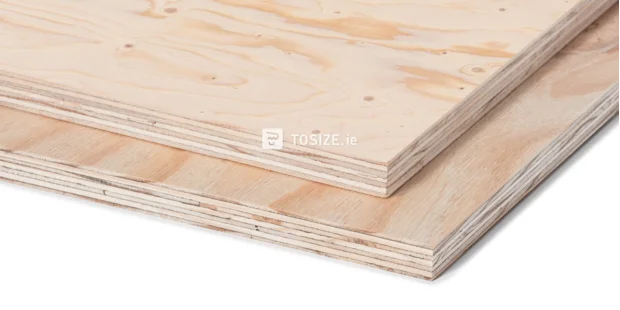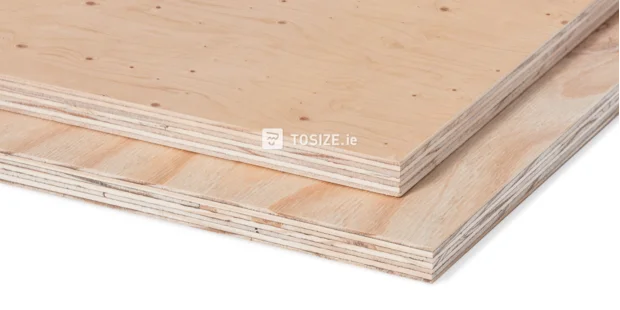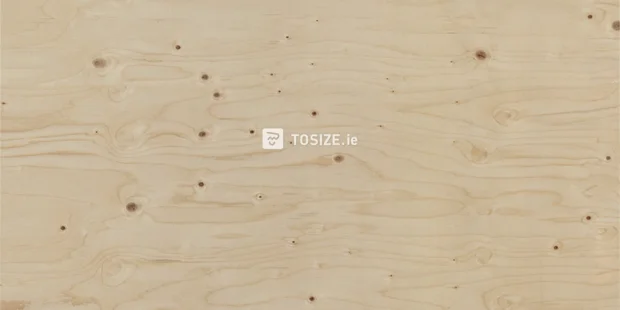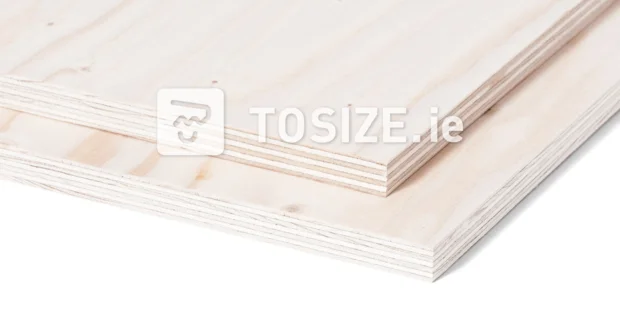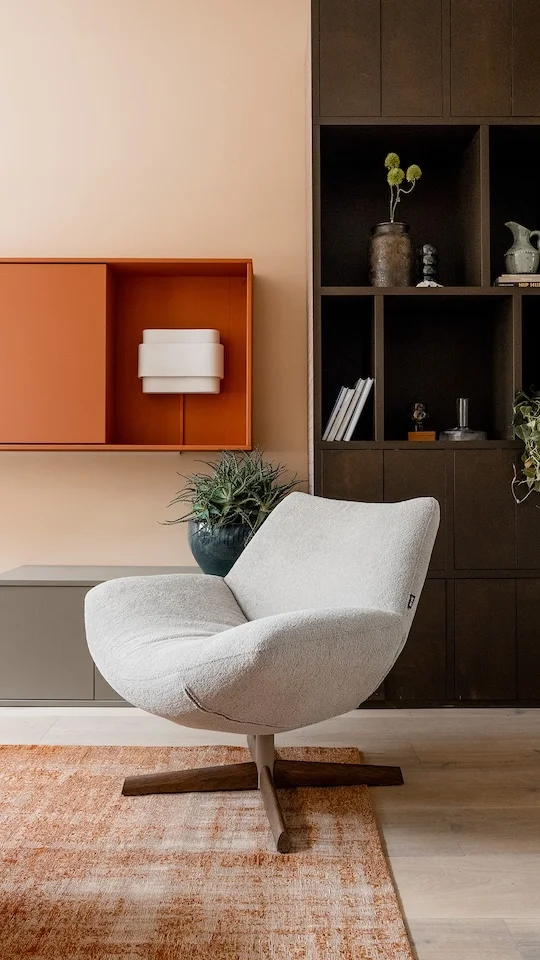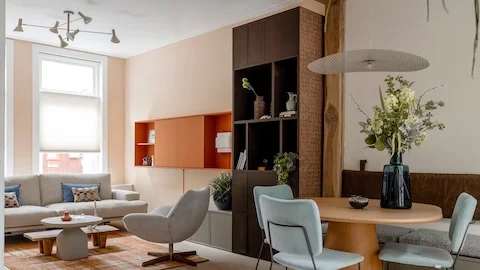- TOSIZE.ie
- Wood and sheet material
Underlayment
Underlayment sheets are structural plywood sheets. Traditionally, this sheet material was often used as a subfloor. That is why it is called underlayment. Today, this strong sheet material with light pine veneer is used for many more structural and decorative applications. Think, for example, of walls and supporting roofs. Because of its appearance, which is very natural, the material is also used for decorative applications such as furniture and worktops.
Order cut-to-size underlayment
Quickly and easily order cut-to-size underlayment online. Buy cut-to-size underlayment or order a circle, triangle or oval shape of underlayment Finnish pine. Buy professional sawing and milling work online quickly and easily. Choose the plywood sheet you need, and we will accurately cut it with the desired shapes and finishes.
Underlayment: what is it?
Just like plywood, underlayment sheets are made of real wood layers. This gives the sheet material both pros and cons. To start with the pros, the visible wood structure gives the sheet a warm and natural look. The original tree determines the appearance of the sheet. By bonding thin layers of wood, both underlayment and plywood can be called a durable product compared to solid wooden sheets.
During the production of underlayment, the wood veneer layers are glued together crosswise. Because of this production method, together with the fact that underlayment is made of real wood layers, the layers can come under tension. During the machining of the sheets, for example when sawing, milling or drilling these sheets to size, this tension may be released. This can cause the sheet material to warp. This mainly occurs with thin underlayment sheets.
The structure of underlayment sheets
Underlayment sheets consist, just like plywood, of glued veneer layers. Where triplex is made up of 3 bonded layers, plywood consists of 5 or more layers. Underlayment takes the cake with 7 bonded layers. This makes the material very strong and stable.
In order to be able to install underlayment as a subfloor quickly, this sheet material is available with a tongue and groove finish, which is not the case with plywood. Underlayment sheets are, as it were, the stronger big brother of plywood, with a rough top layer. Because underlayment is hardly selected on appearance, underlayment is generally cheaper than plywood. The industry does not recommend this material for visible applications.
Because underlayment is budget friendly, more and more handymen opt for underlayment nowadays. Are you looking for a tough look? Then we agree with you!
Properties of underlayment sheets
The sheet is lightweight and easy to incorporate into your project. Underlayment is externally bonded, which means that the boards are moisture resistant. With little effort, you can quickly create a flat and strong surface as an end result; ideal for laying a sleek subfloor.
The disadvantage of both underlayment sheets and plywood sheets, whether they are glued layers or a solid sheet: wood warps. When real wood is used, there is a chance that the wooden sheet will warp. It is therefore important to assemble underlayment and plywood properly while processing this product in your project.
Types of underlayment
Underlayment Finnish Pine is the most popular underlayment sheet material. This variant is very strong and has one of the best looks compared to its other underlayment brothers. Please note that underlayment remains a structural sheet material and is generally not suitable for visible applications. Underlayment Finnish Pine is the best underlayment variant in terms of visual grading. If you are looking for a high-quality top layer, opt for plywood with a high visual grading.
Underlayment Finnish Pine
As mentioned before, underlayment Finnish pine sheets are the most popular underlayment variant within this family. The sheet is lightweight compared to its brothers and has visual grading II/III. Which is comparable to visual grading B. Do you want a strong sheet material with a tough pine veneer layer? Then opt for Underlayment Finnish Pine. Then opt for Underlayment Finnish Pine is also known under the name Pellos Floor.
Underlayment Elliotis Pine
Underlayment Elliotis Pine is the most inexpensive underlayment variant available with visual grading C+/C. This means that the sheet may be touched up with filler when necessary. This sheet can only be used for structural works and is not suitable for visible applications.
Underlayment Radiata Pine
This underlayment variant is more red in colour compared to Finnish pine, comparable to pinewood. In addition, this variant is heavier, which makes it less popular. Depending on the variant, Radiata pine may have defects on both the top and bottom.
Always check the specific product properties for more information. Would you like to read more about the visual grading of underlayment? Then read on here. We offer the highest quality underlayment. Scroll down to discover the current range.
Our range of underlayment sheets includes the following types:
-
Underlayment Finnish Pine
Different colours and top layers of underlayment
There are several variants of underlayment available. Each with its own wood colour. Both the type of wood from which underlayment is made and the number of veneer layers the sheet is made up of can vary. The type of wood that underlayment is made of also has a strong influence on the (visual) quality of the sheet material.
Curious to see what visual grading we have in our range? Find all available sheet materials on this page. Or take a look at the product properties for more information.
Underlayment sheets and moisture
Underlayment is externally bonded. The bonding is moisture resistant, but the wood is not protected. This makes it inadvisable to use underlayment in damp rooms or outdoors.
Available thicknesses of underlayment
Underlayment is available in different thicknesses. Because the sheet material is made of real wood veneer layers, the thickness of the sheet is not always 100% dimensionally stable. View all available thicknesses online here. In our webshop, you can order underlayment 9mm, underlayment 12mm, underlayment 15mm, underlayment 18mm and more and have it cut to size.
DIY tips for assembling and finishing underlayment
Because underlayment is lightweight and stable, it is easy to process. As a result, Underlayment is guaranteed to work faster than other construction sheets. You will complete your project quickly with relatively little effort.
Common applications of underlayment sheets
Due to the versatility of this sheet material, underlayment is used for various projects. Underlayment with tongue and groove finish is ideal for creating subfloors. But underlayment with a straight edge is also increasingly being used for interior applications. This sheet material is often used in construction, but it is also used for (DIY) projects indoors. Think of tabletops, displays, cabinet doors or shelves.
Underlayment in your interior
Due to the increasing popularity of underlayment, we see this type of wood more and more often in interiors. Not surprisingly of course, as the wood has a natural look that creates atmosphere and warmth. Underlayment sheet material can easily be used as a wall cupboard or headboard. Do read up on the visual grading of underlayment before you start!
Alternatives to underlayment sheets
Is Underlayment not what you're looking for? View our entire range of wooden sheets; everything can be cut or milled to size down to the millimetre. Find the ideal wood type for your next project!
Underlayment vs. OSB
Underlayment sheets are similar to OSB 3 boards in terms of construction sheet and have similar moisture-repellent qualities. Both are available with a tongue and groove finish. Because OSB uses (residual wood) chips, it is generally cheaper. However, OSB is a lot rougher than underlayment and should be well sanded and finished before use.
Underlayment vs. Phenolic Plywood
Just like phenolic plywood, underlayment is a variant of plywood. Phenolic plywood has a plywood core with a hard, water-repellent, phenolic resin top layer. Where underlayment is only suitable for indoor or covered applications, phenolic plywood can also be used outdoors.
